Coming hard on the heels of a UCAS report that situated applicant decision making as a central factor in graduate success, the latest report from IFS puts differences in outcome largely beyond student control.
On average, graduate returns to undergraduate degrees are positive by age 30 across socio-economic and ethnic groups. Even from groups (like the most disadvantaged state school students, or Pakistani students) where earnings are generally low, there is a substantial graduate premium.
Not so fast
If we left it there, we could see this as a good news story. No matter who you are or where you come from, higher education will see you earn more over time compared with non-graduate peers. But there is what the report terms “heterogeneity among all groups” – an average value hides a lot of differences in outcome.
For instance, state-educated students from the most disadvantaged quintile of backgrounds saw relatively large gains over non-graduates from the same background. Male graduates aged 30 could expect to earn a salary of £25,000 – low when compared to other graduates – but non-graduates from similar backgrounds at 30 are only expected to earn £20,000. This is a large net gain, but does not erase the structural inequality.
Likewise, Pakistani men and women see very high average returns at age 30, but have the lowest graduate earnings of any ethnic group (£23,000).
Some of these differences can be linked to provider or subject choice – a theme that has been explored in other IFS work. But these choices are also linked to background and ethnic groups – and there are also (larger in magnitude) “unexplained” differences between these groups that cannot be attributed to the subject/provider effect. There is a concerning negative difference between white males student, and male students of all other ethnicities.
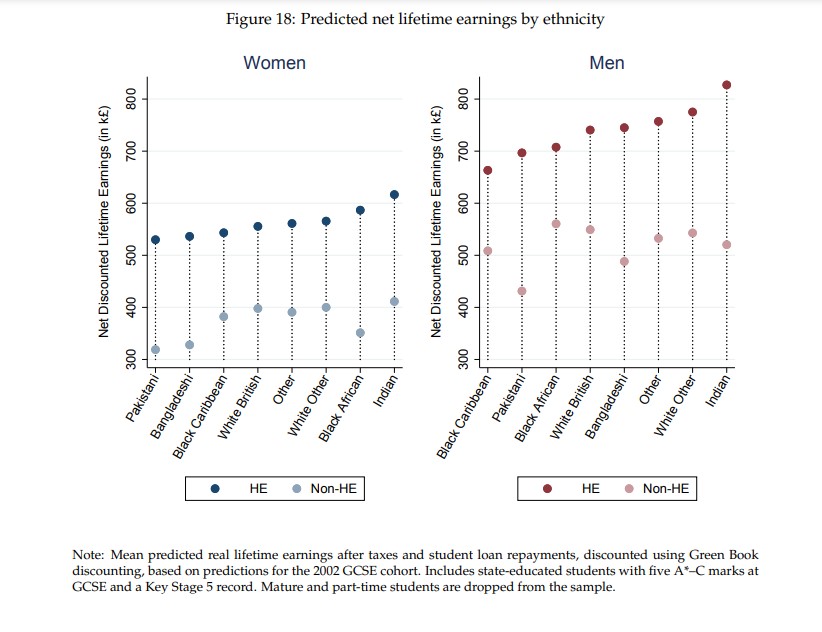
Equality and university choice
Put simply, students from disadvantaged backgrounds are far less likely to attend Russell Group universities. We already know this from years of widening participation data, but the IFS decision to separate out independent school backgrounds makes the difference stark. Around half of all higher education students who attended independent schools were at Russell Group universities – compared to 10 per cent of HE students in the lowest SES quintile.
Conversely, more than 40 per cent of students from the bottom SES quintile attend lower tariff universities, compared to 20 per cent of students from the top quintile and 10 per cent of privately educated students. There are interesting patterns by ethnicity too – Black students disproportionately attend less selective universities.
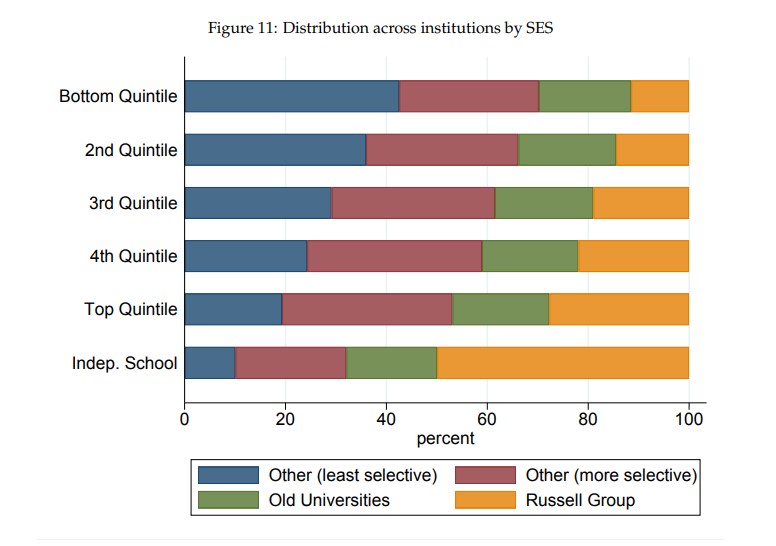
What’s interesting here is there could be a causal relationship in either direction – either more disadvantaged students and Black students tend to go to universities that don’t lead to high salaries in later life, or disadvantaged students and Black students just don’t get high salaries anyway, so the average return from attending the kind of universities they do attend is lowered.
Equality and subject choice
There are also subject choice differences by disadvantage and ethnicity. Students from all ethnicities other than white British are far more likely to take business courses, and students from asian backgrounds are less likely to study performing arts. Disadvantaged students are more likely to study business or computing, less likely to study history or creative arts than the average student. More generally, students from wealthier backgrounds tend to enroll in courses that lead to higher salary returns.
Again, you could make the same argument about causality and direction – but here it is clearer that more advantaged students are aiming at professions that provide higher salaries. This could be due to any combination of an information gap or a prior attainment gap, though I would suggest the latter is more important.
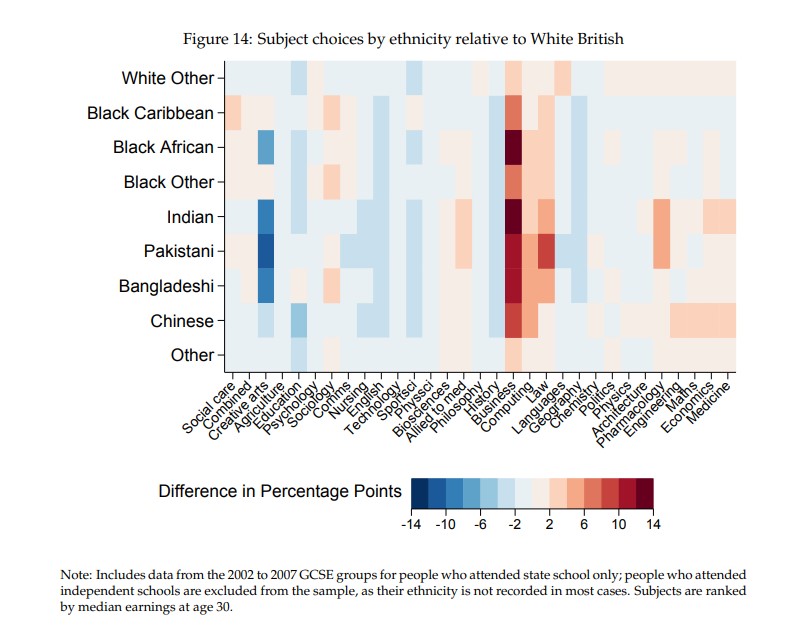
Overall outcomes
If you look at average lifetime returns, the actual variance by socioeconomic status is surprisingly small given the other factors in play. Men (especially, though I would caution that this analysis struggles with female career trajectories) who attend independent schools do tend to do better – but for state school students differences are notable but modest.
What is a concern is that returns are almost always lower for Black students than white students, with returns for Asian students above both. Black women, however, appear to achieve on average around twice the average return of white women based on a small amount of data.
IFS argues that subject and provider choices partially drive differences in outcomes – noting access to social network, and effects of labour market discrimination. Elite social groups may contribute to independent school student outcomes, women from poorer families may be more likely to work part time. But I’d be interested to see an assessment of the contribution of social class and ethnicity to provider and subject level performance. University – it seems – can help level the labour market playing field, but there are clearly wider structural issues at work.
An unusual LEO
There’s was a technical problem with Tableau Public at the time I set this article up, so I’ve embedded images. You can get to the underlying interactive visualisations via the [Full screen] links.
We don’t get detailed data along with the IFS release, but as it happens a new and unusual look at LEO data came out yesterday. Providers are the missing variable this time, but we get a lot more information about the detail of subject choice.
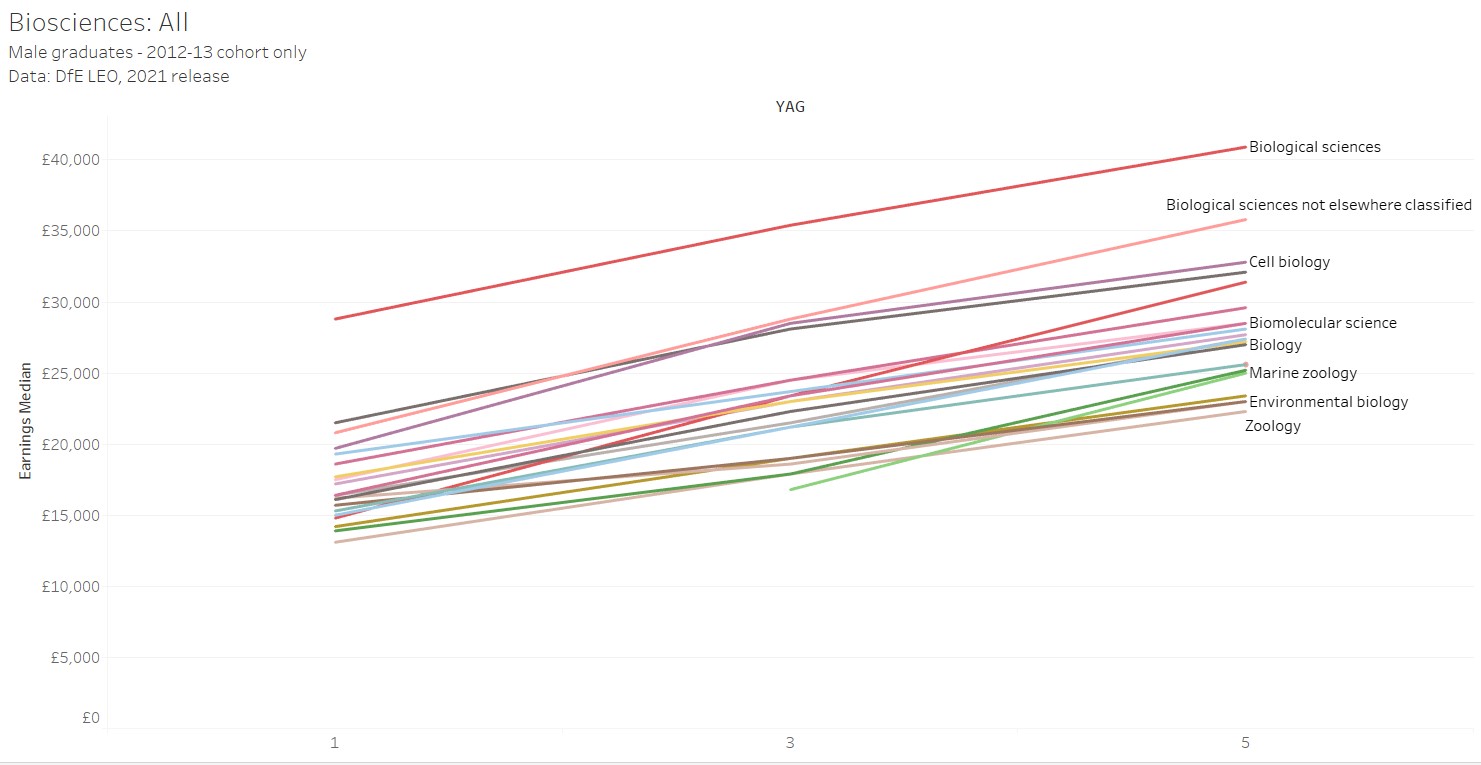
For instance, within the biosciences category, biology brings the highest earnings at all stages, while zoology and marine biology are at the other end of the spectrum. For computing games and graphics related disciplines lead to lower salaries than systems design and software engineering.
There’s also some quite detailed data on salary linked to prior attainment. There’s for men there’s little evidence of an impact from prior attainment in nursing, but in computing level 3 attainment has a salary impact that grows over time.
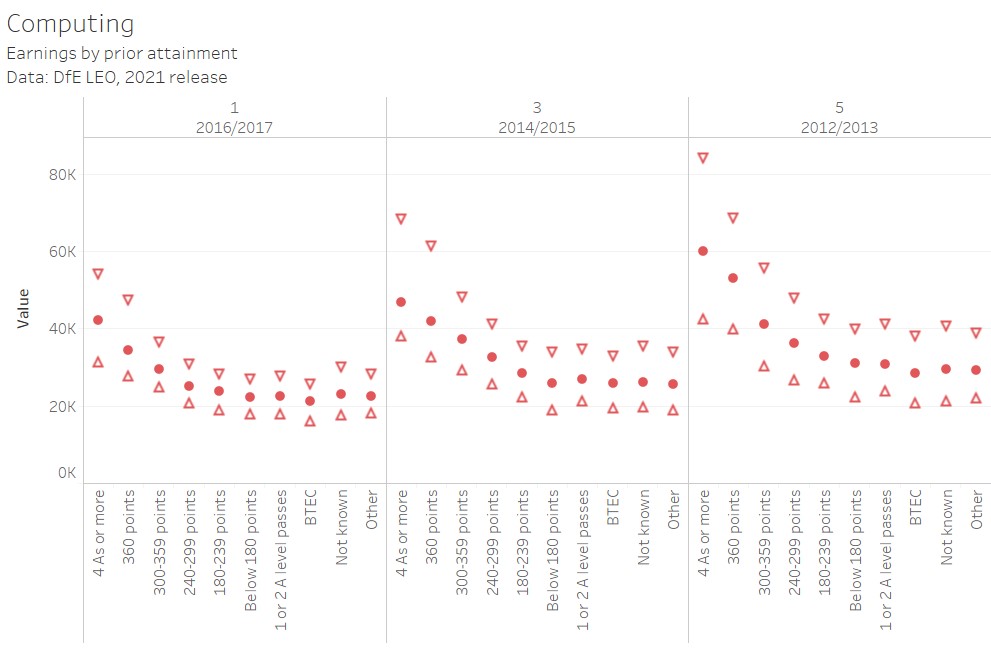
Characteristics matter
Most germanely to the IFS research, we get a whole load of data on graduate characteristics on earnings – by POLAR3 quintile, free school meal status, ethnicity, current and home region, whether or not they live in their pre-university home region, mode of study, provider type, and subject. There are no intersections, but the differences are still striking.
Male graduates from POLAR3 quintile 1 – the most disadvantaged – now on average earn about £3,700 less one year after graduation, £3,200 less after three years, £4,400 less after 5 years, and £4,800 after 10 years than their quintile 5 peers. And the issue has gotten worse over time.
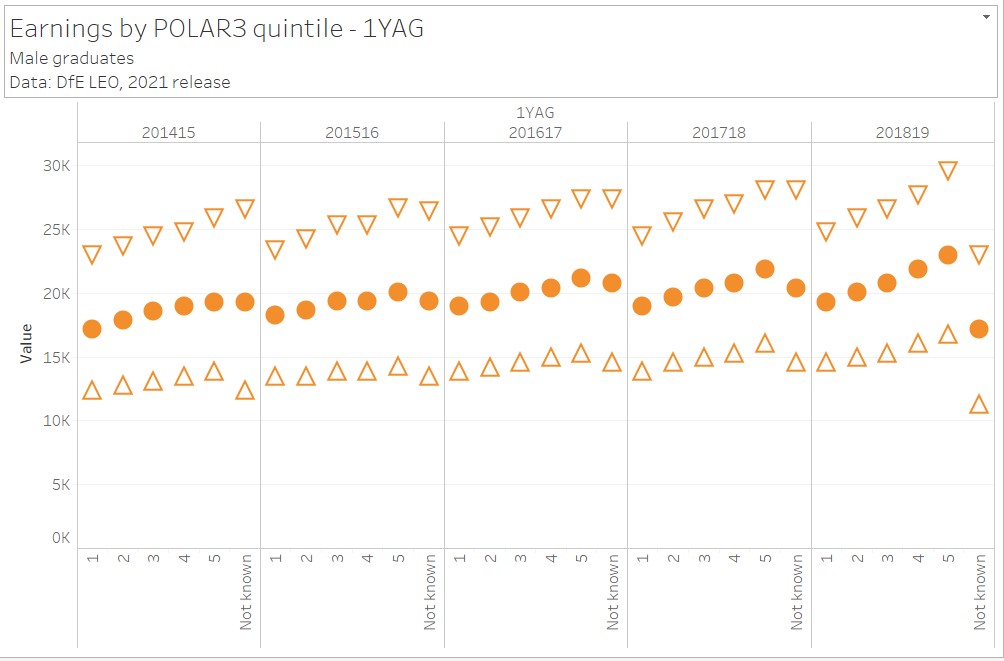
After ten years white male graduates could expect to earn £36,900 a year, Black African males saw £30,700 a year, and Indian males saw £40,000 a year. That’s a £10,000 a year difference based on ethnicity.
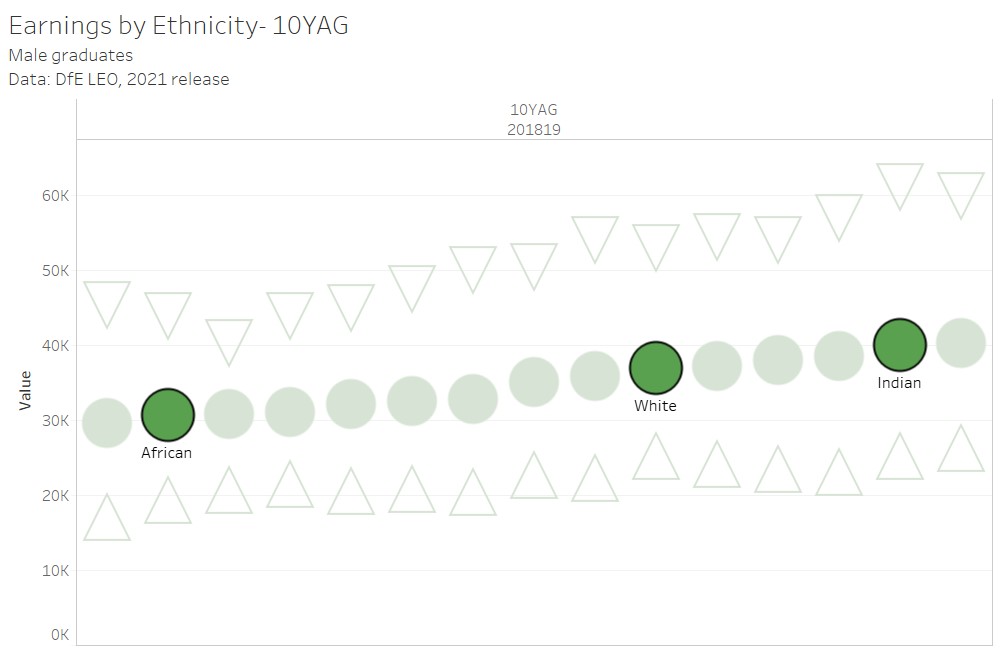
Graduates living in Scotland earn most early on in their careers – but after 10 years living in London brings a significant advantage. Graduates in Northern Ireland and the North of England reliably earn less
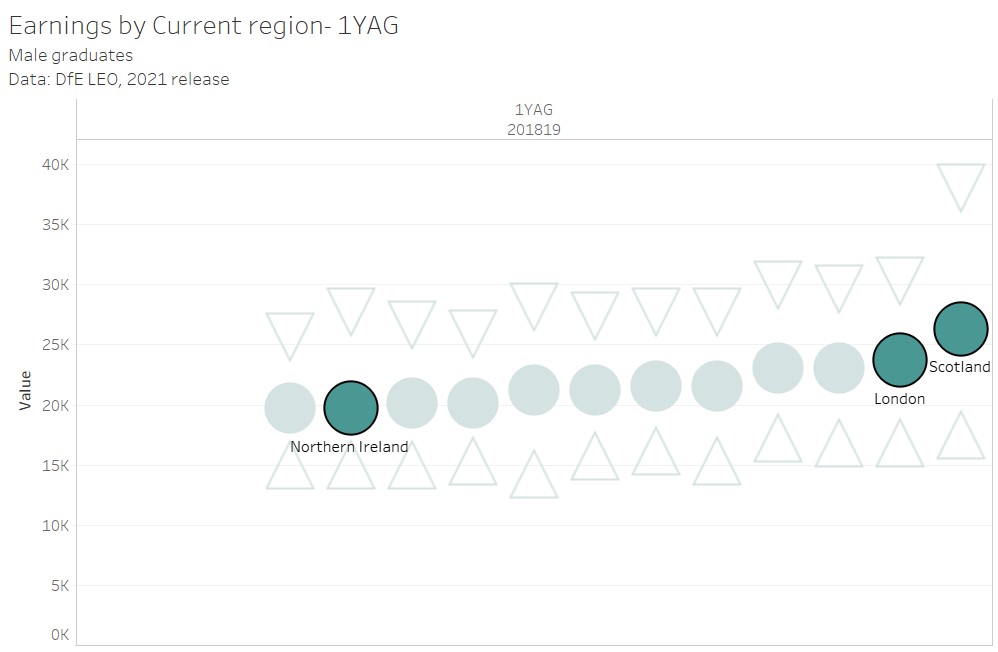
In conclusion
Early analysis of LEO focused on provider, and subject, effects. The more we get on subject the more we see a complex picture of sub-specialists. But it is the data on student characteristics that should have a lasting impact on the sector – there is clearly no reason why an applicant should expect a different return from the same degree at the same provider based on the social class of their family background or the colour of their skin. Whereas it is good, overall, that a degree has a positive impact on earnings for most, we should be very concerned about the variation beneath that.
In particular, we should not talk about subject and provider combinations with “low” salary returns without considering the backgrounds of the students involved. And we should pay as much attention to biases in the graduate recruitment market as we do to gaps in higher education progression.
Data notes: lads, lads, lads
You’ll have spotted that this piece talks entirely about male salaries – something that we very much need to talk about. The underlying methodology has problems with estimating female salaries, as LEO data (still) does not properly handle part-time work or career breaks. As both of these are more common among women, this leaves their salary data almost unusable in this presentation.
You’d think, four and a half years on from the first publication, that some attempt would have been made to sort this out. Many women have careers of a different shape to men, this should not be news to anyone and I find it hard to believe that HMRC data (from which LEO is derived) does not contain information on actual salary and employment terms. Rather than give the misleading impression the female graduates will inevitably earn less, I’ve chosen to highlight the specific data issue in this paragraph. Fixing the part-time and career break issue would particularly make this data set more valuable for understanding women’s salaries – but it would improve all the data immeasurably. Enough stalling, this needs to happen.














Really interesting to see the societal factors which have an impact on graduate outcomes set out in this article. I don’t think it is a surprise for anyone working in the sector that this is the case and it makes it even more ludicrous the suggestion within the recent OfS consultation on quality and standards that absolute baselines should be used in judging the quality of provision at providers.
This really shows the need for measures which consider the ‘value added’ rather than the absolute outcome.
The value-added argument is a strong on the basis of these data. OFS, take note pls.
“Students from all ethnicities other than white British are far more likely to take business courses, and students from asian backgrounds are less likely to study performing arts. Disadvantaged students are more likely to study business or computing, less likely to study history or creative arts than the average student. More generally, students from wealthier backgrounds tend to enroll in courses that lead to higher salary returns… here it is clearer that more advantaged students are aiming at professions that provide higher salaries.”
Can someone explain to me where I am going wrong with this? If disadvantaged students are more likely to study business and computing and less likely to study history and creative/performing arts, and if business and computing graduates can expect higher earnings than graduates of either history or the arts (according to LEO), is it not the more DISadvantaged students who are aiming for the higher salary professions?